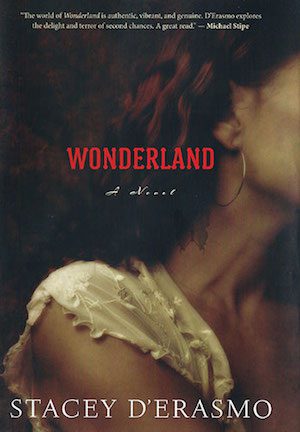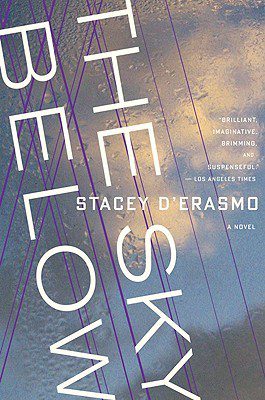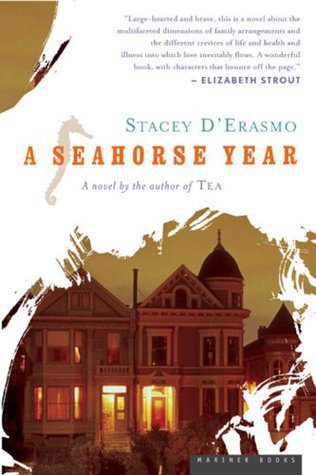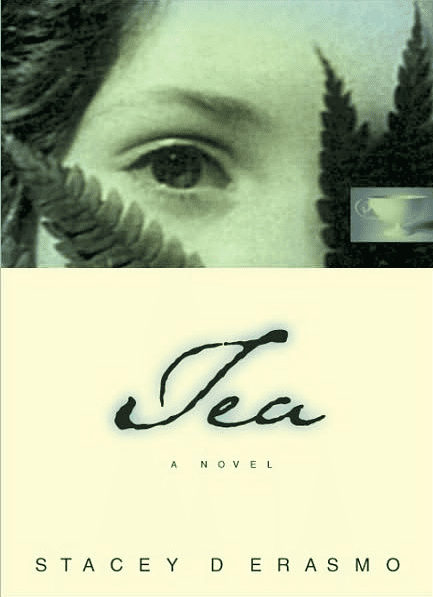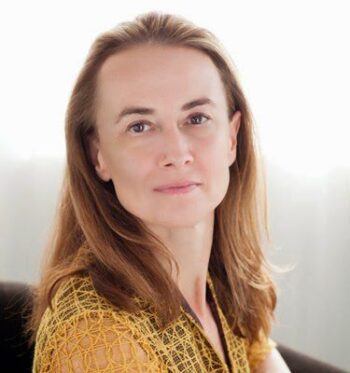
It may seem strange that Stacey D’Erasmo’s new novel, Wonderland, is being called her “breakout book” by outlets including Vogue and Publishers Lunch. After all, D’Erasmo, the author of three previous novels and a book of nonfiction, broke out long ago: her first novel, 2000’s Tea, was a New York Times Notable Book; her second, A Seahorse Year, won a Lambda Literary Award and was named a Best Book of the Year by the San Francisco Chronicle and Newsday; and The Sky Below was a Chicago Sun Times, New York Times, and Los Angeles Times favorite book of 2009.
But when you meet Anna Brundage, the forty-something rock star whose return to the stage after a seven-year hiatus provides the through line of Wonderland, you’ll understand the hype. Brundage is both an artistic dynamo and a complex everywoman whose quest for fulfillment through music is, according to Booklist, a “transfixing song of a self evolving through discovery, loss, and renewal.”
The daughter of an iconoclastic sculptor, whose long shadow looms over her own career, Anna barnstorms through Europe with a querulous band and a new manager half her age, revisiting old haunts and old lovers, hoping there’s still a place for her in a radically changed music world. Along the way, she tries to repair her troubled relationships—with her father, with her sister, with the lost love of her life—while dealing with eccentric musicians, ambivalent audiences, unpredictable weather, and all the inevitable headaches of life on the road. The Los Angeles Times calls the novel “a distillation of what it means to be a working artist in the early 21st century”—but with its lyrical, introspective prose and its refusal to look away from the things that confuse or shame or wound us, Wonderland is equally an exploration of what it means to be human and alive.
On a recent break from her own tour, D’Erasmo talked to me about writing, art, and the universal urge to seek out our own private “wonderland.”
***
The Rumpus: Do you remember the moment that you had the first idea for Wonderland?
Stacey D’Erasmo: I can’t remember exactly where I was, but the foundational image for the book was in a section now called “The Broken Train,” where Anna Brundage is remembering something that she wasn’t present at: the moment her father, the conceptual sculptor, sawed a train car in half, something that later changed the field of sculpture. Her memory of that moment, her response to that moment, and her thought—“If I could do in music what my father did with the train, I would solve the mystery of my life”—that’s where the book began. That was the navel, always.
Rumpus: It’s your fourth novel. Has the process of writing changed for you? Is your relationship to this book different from your first three books?
D’Erasmo: I felt simultaneously quite free in writing this book and also pretty much dead certain that no one would like it. I thought people were going to find it sentimental or poetic in a goofy way, too much like journal writing. I don’t know what I thought, but I didn’t feel that I had to please anyone—and I also didn’t think that I would. I also just thought, I don’t care. I love my other books, too, but this is the book I deeply need and want to write at this point in my life, and that’s what I’m going to do.
In some ways, it’s the book I would have loved to have written when I was eighteen. I feel like in its sensibility the book goes back to a much more lyrical drive in me that a lot of us were educated out of. At least in the time that I was coming up, there was a certain suspicion of lyricism. I came up during the big Minimalists, when the idea was that language is figurative enough and you don’t need to embellish it. But I’m at a point in my life where it was like, You know what? Too bad. There is something about this that’s really important to me and I’m just letting it rip. I’m just doing it. We’ll see what happens.
Rumpus: Most of the novel takes place on Anna’s tour through Europe, which lends it a strong forward drive—after all, you can’t get off a tour…
D’Erasmo: That’s the thing about a tour: there’s really no internal coherent logic to it. Book tours, too, but music tours are a little more glamorous and fun. They’re a weird, random sequence. If you think of a journey, like a Pilgrim’s Progress or something like that, people are going to a specific place. But on a tour there isn’t an end point. It’s like a picaresque structure more than anything else. And tours move fast. That’s the point. And that informs the structure of the novel—moving from section to section, thought to thought, experience to experience.
Rumpus: But it’s a comeback tour—she’s been out of the music scene for many years when she makes the Wonderland record. As a so-called mid-career writer, did the idea of a comeback tour have a particular appeal?
D’Erasmo: Absolutely. Is the novel also about that? Sure. With your first book, you think, Okay, we’re gonna run! And maybe it happens and maybe it doesn’t. Second book, same thing. And you come to understand those oscillations of hope and disappointment, and the question that is subtly posed to you, which is: do you have the nerve to keep doing this? Do you have the heart?
If you make art seriously, your entire self is in it. Period. None of us is fucking around. We’re not. We are not kidding. We are putting our whole selves into these projects and we go all in again and again and again. And most of the time you get disappointed in one way or another. And the question that begins to occur to you is, Can I do this again?
As a writer in my forties, with three books behind me, I was very much interested in how one takes not the first leap but the fifth. The sixth. Because that’s when you start to understand that there are so many reasons not to. And they’re all good.
Rumpus: For Anna, the question is even more urgent. Writing is more forgiving of people getting older than rock music.
D’Erasmo: In music, especially in the indie rock scene that she’s in, there’s no net. It’s a fast ride, long drop; there’s no tenure track, no fallback position. For musicians, the risk is enormous.
Last week I read an article about how Tori Amos, Sarah McLachlan, and Natalie Merchant have all just released records after a long time away. At the same time, Kathleen Hanna basically came out of semi-retirement and she’s on the road with The Julie Ruin. Of course I’m really compelled by this. They’re women close to my age, out there, their asses on the line—what does it take to do that? And in the case of Sarah McLachlan, who made her reputation as a sincere, hippie-ish Lilith Fair favorite, how does the world now understand her as an adult? People have children, their children grow up, their parents get older, their parents die, they have marriages, they have divorces, they have years of experience in an industry that is famously brutal. And that just really interests me.
With all of this stuff, we’re dealing with myth. When we look at these stars, what we’re apprehending and creating are fantasies. Part of what’s magical about these people is the fact that there’s room for the audience to invent their own versions. I don’t need to know who they really are. It’s not my business. But we make myths out of them, and the question is, are they still productive mythic sites when they no longer represent the endless possibilities of youth? I think of course the answer is: yes, but different. When we listen to Bob Dylan, or Kim Gordon, or Joni Mitchell now—aren’t we listening for the depths of those lives?
Rumpus: You have a number of musician friends, and you toured with Scissor Sisters while you were researching Wonderland. How glamorous and fun was it, really?
D’Erasmo: I did an event with Beth Orton the other night and she said, “You know it’s funny, because really touring is so boring!”
What we see as audience, or as consumers, are the high moments, the moments when people are onstage, doing this great thing. One of the things that was really important in creating the aesthetic of Wonderland was to understand how much drifting downtime there is on a tour, and to understand what it takes to live between stations that way. Because actually the definition of a tour in many ways is that you’re always between, you’re in motion, and a lot of that motion is uninflected. You’re just moving through space. And sometimes it’s cruddy and lonely and dirty and difficult, and you’re trapped in the same roles, with the same people. If you’re the lead singer, you’re the lead singer every day. If you’re the drummer, you’re the drummer every day. The internal fortitude that’s required to deal with that seems to me to be substantial. It’s so much stranger than our popular fantasies about it.
Rumpus: The atmosphere you create around Anna’s early success is reminiscent of that period in the 1990s when a lot of attention was suddenly being paid to female artists. Did you have particular models in mind?
D’Erasmo: If you took Beth Gibbons, Aimee Mann, Dar Williams, PJ Harvey, a dash of Patti Smith, and put them in a blender—that would be who Anna is to me. Also, I was a teenager during the heyday of Joni Mitchell. I think she changed my brain, and changed whatever ideas I had about what popular music could be. She educated an entire generation. If you went with her from Blue through Court and Spark, through Hejira, through Don Juan’s Reckless Daughter, through Turbulent Indigo—she was teaching you. She was teaching a generation of us to open up our ears. So for sure, Anna comes out of that lineage.
Because the ‘90s, with that explosion of indie rock, also had a lot to do with permission—the permission to make new sounds. There were new ideas about what you can do in music. One of the inspirations for the book was Patti Smith’s comeback, because she came back not as a Madame Tussaud’s version of herself—she came roaring back, and that’s beyond miraculous. Anna’s not a punk rocker, but she certainly comes out of that tradition or that moment.
Rumpus: And like all those groundbreaking artists, Anna is a woman in a man’s game, controlling her own fate. And that has its ups and downs…
D’Erasmo: As it does for all of us! But I have to say, there have been many really big, powerhouse women rockers for many years—and I don’t just mean the last five—but it’s strange to me how little a woman like Anna has appeared in fiction before. Because in the world, there are a lot of them.
Especially now. The music industry has obviously had a lot of troubles for a long time. But it’s like the breakup of the movie studios: when that hyper-controlled, big-capital, star-making industry got taken apart, it allowed room for incredible variety and diversity, not only demographically but also formally.
Rumpus: Lately there’s been a renewed focus on the question of “likability,” especially in fiction written by women, starting a few months ago when Claire Messud objected to a question about whether she would want to be friends with the protagonist of her new novel. When you’re writing a character like Anna, do you give any thought to whether readers will “like” her?
D’Erasmo: Virginia Woolf said, a hundred years ago, “You must kill the angel in the house.” The angel in the house was that Victorian ideal of the long-suffering, mother-of-the-world character, and Woolf said you have to kill her in order to write, to create. I would say that in the twenty-first century one still feels a certain amount of cultural pressure to not say certain things, and I have strong muscles for resisting that. Mostly because I feel that every single one of us on the planet is flawed and is doing his or her best to get through the damn day. And if you create characters who do not have as many edges and fissures and incongruous places as real people do, then you are failing to love your characters sufficiently. Because you’re saying, “I’ll be interested in you as a character so long as you behave in socially acceptable ways.” And that to me is very poor art.
Anna has some edges, of course she does. So do I, and so does everyone I love. If we cannot love people in their complexity, then we’re rather cruel and cold as a culture. If we only love our female characters when they are either giving or suffering, then we are really shortchanging ourselves as human beings.
Rumpus: Ironically, the music world that Anna lives in values limit-testing and transgressive behavior in a way that contemporary literature, despite its self-image as a bastion of artistic freedom, might not.
D’Erasmo: Right. I think there are some lingering dowdy-isms and resistance to formal innovation in the literary world. You can read reviews any day of the week that complain that a novel doesn’t have a conventional narrative structure. But not all books have to do the same thing.
For musicians, it’s true that there’s a premium on being modern, being the new thing, a premium on transgression. I did an event with Michael Stipe at the PEN Festival and he talked about how, in the middle of one concert back in the day, he tried to take a shit on the stage to protest something. That’s not going to happen at the PEN/Faulkner Awards! Writers aren’t asked to push the envelope in that way. And in some ways that’s good—because sensationalism only goes so far. But in other ways, things can get inhibitive and restrictive.
Rumpus: What about your female students? Are younger writers still inhibited by these dowdy-isms?
D’Erasmo: I hope not. I certainly don’t want to impose that on them and I hope that I never do. A lot of my female students are more interested in mixing forms and in changing and creating forms than some of the boys—not all of the boys, to be sure. But a lot of my female students like things that combine fact and fiction, that combine fiction and poetry, things that move around in an odd way. I have no idea why that is. There’s a generational difference, so I don’t know what they’ve read that brings them to that a little more than the boys.
Rumpus: In a recent essay in The New Yorker online, you wrote, “In the course of long artistic careers, women are more likely than men to change form and style, Proteus-like.” But it sounds like you’re saying that protean attitude may be built into some women’s approach to writing from the beginning.
D’Erasmo: It’s funny, that article got a lot of comments like, “You are wrong!” But it was meant to be more of a conversation starter than a pronouncement. I remember, with my second book, I felt I really had to make something with a very causally-based, driving plot. Partly I wanted to see if I could. And I also felt like I should do that. And as I get older those ideas about what I should or shouldn’t do get a lot less. And I do think that there’s something in the female condition—and sometimes in the condition of being a person of color, or the condition of being queer, or trans—where you’re just a little more like, Let me try that. Let me see if that can get close to it. Let me see if I can express it a bit better.
Rumpus: The visual art world is a huge presence in this book, as it was in The Sky Below. And earlier you said that this novel began with the moment when Roy Brundage makes his name as an artist by sawing a train car in half. Why was that image so powerful for you?
D’Erasmo: I’m not a visual artist. In the same way that I have no musical talent, I can’t even draw a stick figure of a dog! These are capacities I don’t have. I’m astonished by what people can do with the things of this world, with matter. Visual artists—whether it’s Robert Smithson making Spiral Jetty, or Monet making Water Lilies, or Helen Levitt making street photography in the 1930s—they do things with the stuff of this world that very often has mass, literal mass: tactile, physical mass. I don’t work in mass, I work in language. And I’m fascinated by people who can make things actually appear in the world. It’s very moving to me.
There’s a kind of parallel structure in the book: I made Anna, who does something that I truly cannot do; Anna is struggling with the legacy of her father and his breakthrough work—he does something that she cannot do. And the father, you might say, is up against gravity itself. He is working in gravity, essentially. And ultimately it defeats him. In a way, these are images of loss, of yearning, and of an irreducible difference between and among people and artists who can do different kinds of things.
To me, artists are heroes. Honestly. No one in my family is an artist, and to me artists are heroic. You’re doing something no one wants you to do, that no one cares about, where the rewards are often slim to none. It is simply the passion for vocation that keeps people going and I find that endlessly moving and heroic. It just fascinates me.
So visual artists, to me, are like people who can breathe underwater. They’re like mermaids. There’s a guy up at Dia:Beacon, one of these big minimalist guys, Fred Sandback, who suspended these pieces of string from floor to ceiling at certain angles. And what these pieces of string do is form ghost planes that, even though it’s just pieces of twine with nothing between them, make you suddenly aware of the mass of space. When I saw those pieces of string I suddenly understood something about existing in time and space that I had never understood before. And that kills me. How did he do that?
Rumpus: When Anna recounts the success of her first album, Whale, she remembers her musical breakthrough, a moment when she “passed through the eye of the needle” and discovered “the central importance of the unheard chord, the chord that is never played, the chord that happens after the music ends.” Were you thinking of those strings when you wrote that?
D’Erasmo: Absolutely. It’s becoming aware of parts of existence you can’t necessarily see or hear. I just find that exhilarating. There’s a YouTube video where Frank Zappa went on The Steve Allen Show and played a bicycle. He made a musical instrument out of a bicycle. Could you love someone any more? What kind of wild, free imagining and guts does it take to do that? I find that the most courageous and heroic thing in the world.
Rumpus: But it’s notoriously difficult to write about other art forms. And yet, in Wonderland, the passages describing Anna’s music and performances are some of the most thrilling writing in the book.
D’Erasmo: They were the hardest parts of the book to write. I don’t like being onstage. After four books, I can do it, but I don’t love it. So those were the parts of the book that I was least confident about, and where I thought it could end up cheesy and bad and wrong. Because what the hell do I know? I loved writing those sections, but I really had to dig deep and push into an intuition and hope I was going in the right direction. Because I don’t work in sound—not like Anna does. Writers work with sound, but we maybe work in three dimensions while musicians work in four or five.
The other thing about it is that musicians don’t always talk to you about that part. It’s so private, in a way, that they don’t talk to you about what it feels like. That’s what I want to know. That’s the thing we want to get inside of.
Rumpus: In a way, that’s what “wonderland” comes to mean in the novel: that private, almost ecstatic experience. At one point, describing a moment when the band really comes together, Anna breaks off her narration and says, “I can’t describe the next part.”
D’Erasmo: This is where anyone who’s making art shares something very key. Whether you’re writing or making music or painting, whatever it is, there’s that place you enter into, that astonishing, internal, completely unique moment where the thing happens. And that is Wonderland. That’s what we live to do.

